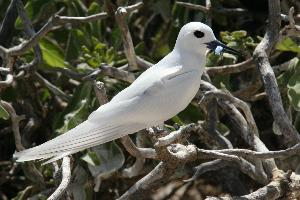
State of endangerment
| Endangered |
Animal description
The Antarctic Tern (Sterna vittata) is a fascinating and resilient seabird belonging to the tern family, which encompasses a wide variety of species known for their graceful flight, fishing prowess, and often long migratory patterns. This particular species is closely associated with the cold, harsh environments of the Antarctic and sub-Antarctic regions, showcasing several unique adaptations that enable it to thrive in these extreme conditions.Physical Description:
The Antarctic Tern is a medium-sized bird, typically measuring about 31-38 cm in length, with a wingspan ranging from 77 to 98 cm. It has a slender, streamlined body that is well-adapted for both efficient flight and swift aquatic maneuvers. The plumage of the Antarctic Tern during the breeding season is predominantly grey and white, with a strikingly sharp contrast between its pure white underparts and darker grey upperparts. One of its most distinctive features is its bright red bill and feet, which stand out against its more subdued body colors. The bird also sports a black cap on its head, extending from the bill to just beyond the eyes, which fades to white during the non-breeding season, making it one of the key identifiers of its seasonal changes.
Habitat and Distribution:
The Antarctic Tern has a circumpolar distribution, primarily inhabiting coastal regions and offshore islands of Antarctica, as well as various sub-Antarctic islands. During the breeding season, it prefers rocky shores, cliffs, and sometimes more inland areas for nesting, often choosing sites that offer some protection from predators and harsh weather. In the winter months, it migrates northward but remains over the cold waters of the Southern Ocean, rarely venturing into more temperate zones.
Behavior and Diet:
The Antarctic Tern is an adept hunter, primarily feeding on small fish and krill, which it catches with remarkable precision by plunge-diving into the ocean from considerable heights. It is also known to feed on small crustaceans and cephalopods, showcasing a degree of dietary flexibility that helps it survive in its nutrient-variable environment. The tern's hunting technique is a testament to its mastery of both air and sea, as it seamlessly transitions from soaring flight to underwater pursuit.
Reproduction:
Breeding typically occurs during the Antarctic summer, from October to December. The Antarctic Tern is monogamous, with pairs often returning to the same nesting sites year after year. Nests are usually simple scrapes in the ground, sometimes lined with vegetation or small stones. The female lays one to three eggs, which both parents then incubate for about three to four weeks. After hatching, the chicks are semi-precocial, remaining in the nest but requiring parental care and feeding. Both parents are involved in feeding the chicks until they fledge, which occurs approximately one month after hatching.
Conservation Status:
Currently, the Antarctic Tern is classified as Least Concern by the International Union for Conservation of Nature (IUCN), indicating that it does not face any immediate threats of extinction. However, like many species dependent on polar and sub-polar ecosystems, it could be vulnerable to the long-term impacts of climate change, which could alter its habitat and food availability. Conservation efforts aimed at protecting the Antarctic environment indirectly benefit the Antarctic Tern, highlighting the importance of comprehensive ecosystem management strategies.
In summary, the Antarctic Tern is a remarkable example of adaptation and resilience, thriving in some of the planet's most extreme conditions. Its life cycle, from its migratory patterns to its breeding and feeding behaviors, reflects a deep interconnection with the marine and coastal ecosystems of the Antarctic and sub-Antarctic regions. As such, it serves as a compelling symbol of the wild and pristine nature of these remote landscapes.
Similar Animals
New photos of animals
Top 10 animals
- Dolphin gull (Leucophaeus scoresbii)
- Diana monkey (Cercopithecus diana)
- Moustached guenon (Cercopithecus cephus)
- Galápagos tortoise (Geochelone nigra complex)
- Stone loach (Barbatula barbatula)
- Japanese macaque (Macaca fuscata)
- Greek tortoise (Testudo graeca)
- Russian tortoise (Testudo horsfieldii)
- Common flying dragon (Draco volans)
- Galápagos penguin (Spheniscus mendiculus)


